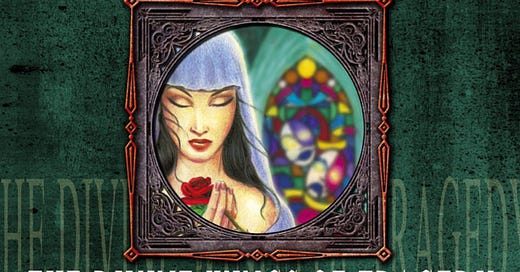Genre of the Day - Neoclassical Metal
Album of the Day - The Divine Wings of Tragedy by Symphony X (1997)
Perhaps the greatest lesson of this column has been the ideal of resolving incongruences, of the endless ability of disparate ideas to converge and create new possibilities. With a little dusting of musical magic, artists can create any musical vision they want. This most often appears in fusion genres like today’s. This capacity is an implicit reminder that we are capable of bridging our own complications, that we can reinterpret our weaknesses as covert strengths. Certain genres like today’s act as testimonies to that intention.
Neoclassical metal draws from two different regions that both fall upon the most intense and dramatic end of the musical spectrum. Metal has a flair for maximally exploiting an instrument, pushing the guitar to its most complex and heaviest limits. The classical music era neoclassical music mostly draws from Baroque music, which has some uncanny similarities to the approach of metal—Baroque rhythms were unrelenting, with little rests and a persistent drive. Terraced dynamics, sudden shifts in volume emphases, mirror the breakneck shifts of metal passages.
Prog rock and hard rock’s ambitious concepts loomed across the great rock ecosystem coming out of the 1970s, as neoclassical metal emerged in the early ‘80s. The genre retains the core instrumentation of metal, with complex and refined musical structures drawn from classical music—the use of high-velocity arpeggios, ostinatos, vibratos, and complex interchanges between keyboardists and guitarists assert instrumentalists’ virtuosity and prowess. Expanding metal song lengths into full-on suites engages musicians; creative visions, working with the broad vision of composers in building out each part of a piece while maintaining the tight bond between an individual and their instrument as they shred across the fretboard with eagle-eyed precision.
Deft, technical, yet still glamorous and luminescent riffs open “Of Sins and Shadows,” the lead singer’s voice summoning the proper degree of drama for lyrics that don’t quite convey ambition as well as the excellent guitar work. Atmospheric acoustic guitar and chime soundscapes give brief breaks between meticulous, killer riffs in “Pharaoh,” advancing to speeds and sending the melodies upwards with the urgency of flare signals. The 20-minute centerpiece “The Divine Wings of Tragedy” begins with a towering hymnal chorus, before an odyssey of shredded glory transpires for a riveting suite. Transpired, plaintive piano eases the listener towards the end as you digest the unbroken release of mesmerizing, dynamo guitar expressions. Neoclassical metal expands the envelope of epicness to new heights—I only wonder if you're supposed to thrash or stand still in amazement.





Metal and Classical are often assumed by casual listeners to be about as different as can be. As you point out, they are actually closely related. They are all about composition and high-level performance. Rock makes lots of room for people who are mediocre at one or the other (or both). Metal is far less forgiving.